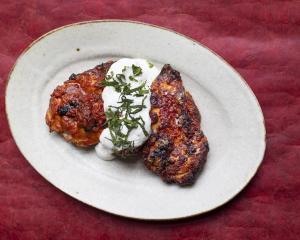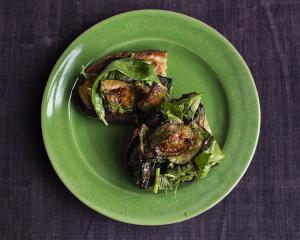Although we were penniless students in the late 1950s, some of the more sophisticated student parties we attended served both ''angels on horseback'' and ''devils on horseback'' for supper.
The only way I could remember which was which was by their colour.
The angels, oysters individually wrapped in streaky bacon fixed with a toothpick and grilled, were white, whereas the devils, the prunes (also enclosed in bacon), were black.
These days the budget doesn't stretch to the Angel variety unless it is a very special occasion, but the devils have always been my favourite anyway.
I love the complex sweetness of the liqueur-soaked prunes which, are wrapped in smoky-salty bacon and grilled or baked in a hot oven.
This is such an amazingly delicious mouthful and quite simple to prepare that I wonder how we could have forgotten about it for so many years.
And the name; where did it come from? And when did these little delights first appear in print?
The earliest mention of angels and devils on horseback in my cookbook collection was the Constance Spry Cookbook 1956.
I phoned Helen Leach, emeritus professor of anthropology, whose enthusiasm and tenacity when researching old recipes is legendary.
She has generously supplied me with dates and information about both the angels and the devils.
It seems that the angels preceded the devils. The inspiration probably came from Urbain-Dubois, French chef to the great German Emperor Wilhelm 1.
His instructions for ''Les anges cheval'' appears as recipe 269 in his book Cuisine de Tous les Pays, published in France in 1872.
In 1879 the Ottawa Free Trader drew its readers' attention to a new dish gleaned from an English newspaper'' 'Angels on horseback' is the name given to oysters cooked in the following way: Place a large cooking oyster in a piece of fat bacon, tie it up with a cord and just toast for a moment before the fire. Serve on a piece of toast.''
During the 1890s both British and American cookbooks published recipes for angels on horseback, including, of course, Mrs Beeton's Book of Household Management.
The angel recipe has spanned the years almost unchanged.
The only puzzle remaining is the name.
One explanation is that as the oyster cooks it curls to resemble wings.
Somewhat fanciful but there doesn't seem to be a better explanation so far.
And so to the devils.
Food cooked in a fiery hot sauce is often referred to as devilled because of the connection between the devil and the excessive heat of hell.
All of the early recipes for devils on horseback contained cayenne pepper, curry paste, English mustard or other hot spices.
The earliest recipe for devils on horseback that we found was published in an Australian newspaper, the North Queensland Register, in 1896.
However, it was a variant and wasn't stuffed with a prune at all.
Instead, strongly flavoured fish (sardines) were skinned, sprinkled with cayenne pepper, then wrapped in bacon and grilled.
Recipes using sardines or anchovies as a stuffing precede the prune version and were found in British publications from the 1890s.
The fish version lost popularity during the early 20th century and the prune rolled in bacon replaced it.
The earliest recipe we found for the prune version was published by Florence B. Jack in her 1914 book Cookery for Every Household.
''Roll a stewed and stoned prune inside a strip of bacon. The prunes must be tender without being too soft and they must be well drained from their liquid. The prune itself may be stuffed with a devilled almond or a little devil paste.
"Fix the rolls with tiny wooden skewers or a piece of a match. Place them on an oval-shaped piece of buttered toast and place in a very good oven until the bacon is thoroughly toasted. Serve very hot.''
During the 1920s the prune was stuffed with chutney and an almond or sometimes just an almond, but always with some form of devilling, usually cayenne pepper.
During World War 2, when almonds were scarce in both Australia and New Zealand, the prune, simply sprinkled with cayenne pepper, was then wrapped in bacon.
After the war, new types of savouries vied for attention, especially dips, and devils on horseback faded from popularity.
In the 1950s, recipes for devils reappeared, but without the devilling.
Traditionally, both angels and devils were served on small pieces of buttered toast at the end of the meal.
Today however, they are served without the toast as a canape or nibble with a drink before dinner.
I have been experimenting with devils for several weeks now and although every batch has been delicious, there are some variations I like better than others.
I stuffed some with almonds, but my first reaction as I bit into the prune and encountered the almond was alarm that the stone had not been removed.
Spicing the prunes up with cayenne pepper tended to overwhelm the sweet-smoky flavour of the bacon-prune combination.
I tried stuffing the prunes with a smidgen of blue-vein cheese but it completely dominated everything.
Then I tried a creamy blue but it oozed all over during cooking as did the Edam and the Parmesan cheeses.
However, there are two variations that are superb.
Stuffing the prune with a tiny cube of goats' milk feta (it has a high melting point) or a vintage cheddar adds a wonderful depth of flavour.
Neither of these cheeses melts and oozes out during cooking.
The cube of cheese must be small enough for the prune to enclose it totally.
I still love the traditional devils: the brandy-steeped prune, wrapped in a smoky-salty bacon rasher and cooked briefly in a hot oven.
Classy, classic and so delicious. Do include devils on horseback in your easy-nibbles-to-serve-with-drinks repertoire over the Christmas season.
Devils on Horseback
Makes 24
Ingredients
Prepare ahead and bake when convenient
24 large pitted prunes
3 Tbsp brandy or red wine or orange juice
50-60g goat's milk feta (I use Ornelle) or a vintage cheddar cheese (optional)
8 rashers streaky bacon cut into thirds crossways
Garnish
24 dried cranberries
24 fresh thyme sprigs or leaves
24 toothpicks, for serving
Method
Place the prunes in a small, deep microwave container and pour over the brandy, red wine, or orange juice. Cover with cling film and microwave at 50% power for 2 minutes. Toss gently and leave to soak and swell. Set aside until completely cool.
Heat the oven to 200degC.
Line a lipped oven tray or shallow baking dish with non-stick baking paper.
If making the cheese variety, make a small incision in each prune, being careful not to cut all the way through.
Cut the cheese into small cubes about 1cm square and place each square into the centre of a prune. Fold the prune around it so the cheese is completely enclosed. Wrap a length of bacon around each prune and place it seam side down on the baking tray and it will not unravel. No need to secure it with a toothpick.
These can be covered in the fridge for up to 24 hours, but bring to room temperature before baking. Place the tray in the oven preheated to 200degC and cook for 10-12 minutes until the prune is plump and hot and the bacon is cooked through. Timing is critical. Too long in the oven and they shrivel and dry out.
Drain on paper towels then arrange on a serving platter. Top each with a dried cranberry then secure with a toothpick. Garnish with a tiny thyme sprig or leaf.
I think these are best served warm or at room temperature.












